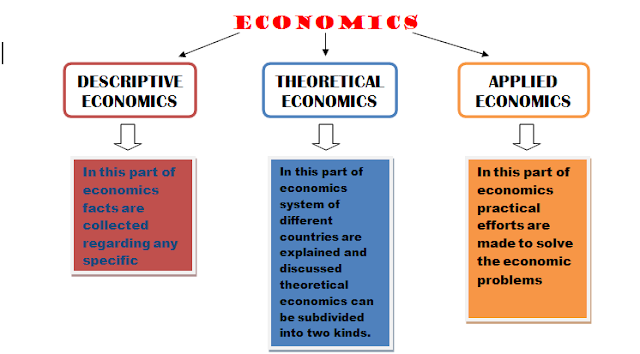Micro economics | Introduction merits demerits |
In
the beginning, there was only one economics. After the great depression of
1930`s they become two,
· Micro Economics
· Macro Economics
In
micro economics we study the economics system by parts where in macroeconomics
we study as whole. “Micro Economics” is
also called as “Price Theory” where as macroeconomics is called “hypothesis of
pay& employment”.
DEFINITION OF ECONOMICS:-
According to Robbins
“Economics is the science which
studies human behaviour as a relationship between multiple ends (unlimited
wants) and scares means (limited resources) which have alternative uses.”
Micro Economics:-
Micro economics is defined as,
“Micro economics theory studies the
economic behaviour of individual decision making unit such as the consumer,
resources owners (producers) and business firm in an economy.”
Main parts of micro
economics:-
Fallowing are the main parts of micro
economics.
1. Production of wealth:-
Production means the
production of goods and services with the help
of four factors of
production. They are land, labour, capital and organisation.
i.
Land:-
All the natural resources
which are used in the process of production are land. It is a gift of nature
i.e. soil, forest, mountains, mineral deposits, rivers etc.
ii.
Labour:-
Human efforts, physical or
mental done for the sake of rewards. It is the services of the labour which are
bought and sold in the market not the labour itself.
iii.
Capital:-
Manmade resources which
can assist in type process of production i.e. cash, machinery, building, roads
etc. these are two types of capital
· money capital
· real capital
iv.
Organization:-
The act of combining the factors of production is
known as organization.
2. Exchange of wealth:-
Producers usually produce
more goods and services then their own
requirements surplus production will be exchanged in
the market with the surplus goods and services produced by others. This process
enables everyone in the society to satisfy their multiple wants.
3. Distribution of wealth:-
When producers sell their
manufactured goods in the market and get
revenue, then this amount will be distributed among
four factors of production as their rewards.
i.
land gets rent
ii.
labour gets wages
iii.
capital gets
interested
iv.
organization get
profit
4. Consumption
of wealth:-
The ultimate objectives of the production, exchange
and distribution
is consumption. People use their shares of income to
satisfy their multiple wants. The process of deriving utility from goods and
services is known as consumption of wealth.
MERITS OF MICRO ECONOMICS:-
Fallowing
are the merits of micro economics.
1. Individual Decision:-
Micro
economics is helpful for analysing individual decision making units e.g.
individual consumer an production unit.
2. Rational Decision:-
The
study of micro economics is helpful for making rational decisions regarding
maximization of satisfaction by the consumer and maximization of profit by the
producer.
3. Helpful in understanding free market
economy:-
The
microeconomics helps us to understand the working of free market economy
without central control.
4. Helpful in understanding macroeconomics
concept:-
Macroeconomics
is the addition of individual behaviour, as a society is composed of
individual, so macro economics is composed of micro economics, and it is
helpful for understanding macroeconomics.
Demerits of micro economics
Following
are the demerits of micro economics.
1. Free
market economy problems:-
In
free enterprise economy, there are always problems of depression, over production
and price fluctuation. There is no stability in the economy and these problems
are studied at micro level.
2. Its
study part of the economy:-
In micro economics, we study parts of the economy
individually; we do not study the whole economy at a time.
3. Individual
results:-
Some
results are beneficial at micro level but not suitable at micro level/ national
level, they are increase in prices, wage rate and purchasing power, personal
saving, consumption rate.
a. Increase
in prices:-
Increase
in profit due to increase in prices is treated well for producers, but general
increase in the price level of product creates inflation in the economy.
b. Wage
rate and purchasing power:-
A
producer can increase profit by reducing the wages, but due to this purchasing
power of labour decrease, it fall the demand for investment and creates
unemployment in the economy.
c. Personal
saving:-
Personal
saving looks good but if major portion of incomes are saved, so investment
decreases and its creates depression in the economy.
d. Consumption
rate:-
Decrease
in consumption at individual level is treated well but if consumption
expenditures decrease beyond a certain level in the economy, rate of investment
goes down therefore unemployment increases.




Post a Comment